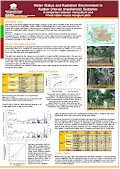| Poster |
 |
|
| Title | Water Status and Radiation Environment in Rubber (Hevea brasiliensis) Systems: A comparison between monoculture and mixed rubber-Acacia mangium plots | | Author | Ni'matul Khasanah, Thomas Wijaya, Gregoire Vincent and Meine van Noordwijk | | Year | 2008 | | Publisher | World Agroforestry Centre - ICRAF, SEA Regional Office | | City | Bogor, Indonesia | | Call Number | PO0160-08 |
|
| Abstract: |
| Interplanting of Acacia mangium within Hevea brasiliensis plot may be an attractive option for smallholder rubber farmers in the tropics to increase their land productivity. Indeed, the economic prospects for timber is good as timber resource in natural forest has become severely depleted and particularly so in Sumatra where this study is conducted.
A. mangium being a very fast growing tree species, careful timing and management of A. mangium is probably required to reduce light competition with rubber trees. Furthermore a large portion of rubber planted area in Indonesia is subject to two or more dry months during which rubber may shed its leaves and stop its growth. Competition for water use between tree species in periods of low rainfall may be another constraint to growth of the rubber tree.
This study compares a series of growth and physiological parameters measured on rubber trees grown either in monoculture (6 x 3.3 m and 6 x 2 x 14 m) or associated with A. mangium (3 x 3 x 17 m). In the fifth year after plot establishment, variation in the growth of rubber was analyzed in relation to leaf water potential (LWP), light interception by canopy and light use efficiency (LUE). LWP was used as an indicator of plant water status, but also as indicator of competitive strength.
Pre-dawn LWP of rubber and A. mangium shows significant differences between rainy and dry season. LWP of rubber under different systems studied does not show any consistent difference. However, the girth of rubber trees grown, light intercepted and LUE of rainy season in mixed systems with A. mangium was significantly smaller. Thus, the net effect of A. mangium on depressing rubber growth is likely to be primarily caused by shading.
Intercepted of light of A. mangium under different systems study almost the same, however, LUE of A. mangium monoculture during rainy season is significantly higher than A. mangium associated with H. brasiliensis. Thus, without any management such as pruning or careful timing of planting of A. mangium, planting A. mangium and H. brasiliensis on the same plot would be disadvantageous. |
|
|
Download file(s): Click icon to download/open file.
|
| |
File Size |
Description |

|
457 KB |
Softcopy |
|
|
GRP 2: Maximizing on-farm productivity of trees and agroforestry systems
|
| Viewed in 1904 times. Downloaded in 525 times. |